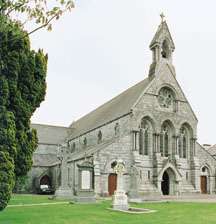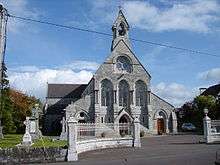Church of St Mary and St John
The Church of St Mary and St John is the older of two Roman Catholic churches in the town of Ballincollig, Ireland. The church was built in the 1860s, funded by donations from the local people of the time, and officially opened on 28 October 1866. The church is in a Gothic Revival style, combined with some features of other periods. It is built of ashlar limestone with roof slates.

The first church
Up to 1808, catholic families living in Ballincollig had to travel to clash cross in Carriganarra, Ballinora or Kilnaglory to attend mass. The increase in the Catholic population due to the building of the gunpowder mills made it obvious that the new church should be erected in Ballincollig. This new church became the parish church replacing Ballinora, which previously had the distinction. The first church was built in 1808 by Fr. Nicholas O’Riordan P.P. in the building which is now occupied by the community hall. The site was given by Charles Henry Leslie for 960 years at the rent of 6d (2½ p.) per year. This man also donated 100 guineas towards the cost of building the church. The bishop of Cork, Francis Moylan, was involved in the negotiations for the site. Some people believe the building was used as a school from the time of its erection. However, from the Ordnance Survey map (1840) we can see that there appear two buildings on the site, one being the church and the other being the school. We do know that after the closure of the church in 1866, the whole building was converted to national school.
The new church

The ceremony of laying the foundation stone of a new Roman Catholic Church in Ballincollig was led by the Right Rev. Dr. Delany, Bishop of Cork, on 13 August 1865. The population of the parish of Ballincollig had grown so large that for a considerable time the chapel which stood on the south side of the village was unable to cope with the large attendances.
The new site was on higher ground less than 100 yards to the south of the old church. It was on the property of Thomas Wise who gave the site free of charge. He also very generously gave the use of a valuable quarry at his property in Coolroe, a short distance away, where all the stone was needed for the building could be got. The total cost was expected to be about £5,000, half of which had already been raised at that stage.
The ceremony of laying the foundation stone was fixed for one o’clock. But because of strong westerly winds and heavy rainfall, it was delayed until two o’clock. The usual mass at twelve o’clock took place in the old church. After the mass the Bishop led a procession to the site of the new church where a long service took place. The ceremony concluded with the bishop passing around the outer limits of the building and sprinkling it with holy water. Then his lordship blessed the foundation stone and it was then formally laid. A collection was made in aid of the funds for the new church and nearly £100 was subscribed on the spot.
Architecture
The building was designed by George Goldie. When it was decided to build a new church in Ballincollig, the most important considerations were that the building would accommodate the people of the parish comfortably and that the building would look attractive. It was with these in mind that Cannon Horgan decided to seek the services of George Goldie who was an English Catholic architect. He had already designed many magnificent churches in England and Ireland. The design of the church was in neo-gothic style, which was typical of this period. The Gothic style of architecture had been revived in the 18th century and was still popular up to 1880. however, Mr Goldie combined features from other periods with the Gothic style and perhaps it is this which gives Ballincollig church its unique characteristics.
Gothic architecture
Gothic architecture flourished in western Europe from the mid-12th century the 15th century. a new system of building enabled architects to design churches with lighter walls and lighter pillars than was possible in Romanesque churches. Many of the pillars had ribs like an open umbrella. Many of the gothic churches also had flying buttresses with brick or stone arched supports built against the outside walls. We can still see the buttresses on the front wall of ballincollig church. Sculptors carved the figures of saints and heroes of Christianity on the columns of the church doorways and windows.
The gothic style never went completely out of fashion. In the centuries after the Middle Ages, various architects used elements of the Gothic style in their designs. But the revival of Gothic as an architectural movement began in the 18th century, reached its peak during the mid-19th century and declined by the 1880s.
It was in the 1860s that the plans of the Ballincollig church were drawn up. It was no wonder that George Goldie used the neo-gothic style.
The construction
The builder employed to construct the church was Mr. Barry McMullen of Cork. The church as it is today is a testimony to the excellence of the craftsmanship of Mr. McMullen and his workers. The walls of the church were made of ashlar limestone (i.e. limestone which had to be individually chiselled into blocked).
The beautiful stained glass for the windows was supplied by messrs. Wiles of Newcastle in England. The windows vary in shape and size from the narrow pointed type (neo-Gothic) to the beautiful rose shaped-windows. The window shapes had to be sculpted by craftsmen and incorporate limestone tracery. The metalwork in the church was done by messrs. Peard and Jackson of London. Most of the ornate metalwork has now been removed, e.g. the altar railings, the metal brackets which held the oil lamps. The railings on the outer wall of the church are the most visible examples of their work. Another very attractive feature of the church is the belfry with its pointed top. It is another example of the Gothic style of architecture. It is made from blocks of limestone and is surmounted with a stone cross. The bell itself was supplied by Sheridan of Dublin.
Stained glass
On a visit to the church there can be seen the names of the people who donated some of the windows. The stained glass window behind the statue of Mary was donated by Barry McMullen. On the window it says; "Pray for Barry McMullen Builder of the church". The stained glass window also behind the statue of Mary reads; "Pray for George Goldie Architect of this church". A stained glass window next to a statue erected by a Murphy family says; "In honour of the Sacred Heart of Jesus". This window was erected by the two confraternities of the parish in 1881. the stained glass window behind the main altar says; "Pray for the very Rev David Horgan of Cork, Priest of Ballincollig who erected the church with help of his parishioners and all the faithful- A.D. 1866." The windows came from Newcastle in England. They are made from Limestone tracery and stained glass.
Dedication ceremony
On 28 October 1866, the church of St. Mary and St. John was dedicated by the Right Rev. Dr. Delaney, Lord Bishop of the Diocese of Cork. The solemn ceremonies were performed with all the customary pomp of the Catholic ritual. The weather was bright and bracing, and a large number of people from the surrounding country came to witness the dedication. Special trains ran to and from Ballincollig on the Cork and Macroom railway, and they were extensively availed of.
At eleven o'clock the church was full. The ceremony of dedication than commenced. A procession emerged from the sacristy. The procession was headed by a cross-bearer and the acolytes; the inferior clergy then followed by the Dean and the canons, Murphy and Browne, closed the procession. It first proceeded to the principal entrance, where the 50th psalm was chanted. The exterior of the church was then encircled, the Bishop sprinkling the walls with holy water and the clergy singing the prescribed psalms. The procession then entered the church by the main entrance and proceeded up the nave to the high altar, where the Bishop knelt. The clergy distributed themselves around the sanctuary. The litany of the Saints was sung and at that point the faithful departed were prayed for. His Lordship rose and prayed that God might bless the church and altar dedicated to His honour and the honour of the Blessed Mother of God and St. John.
The Litany concluded, appropriate prayers followed, and the procession then reformed and proceeded around the interior of the edifice, the officiating prelate sprinkling the walls with holy water. Returning again to the sanctuary, this portion of the ceremonies concluded and the Bishop was conducted to a handsome throne on the left hand side of the altar. Here he robed for High Mass along with the Dean, Canons and deacons. The altar was prepared for the celebration of the holy sacrifice and a little after twelve his lordship preceded to the foot of the altar richly attired in full vestments.
After the first gospel, the very Rev. Fr. Brigitt delivered a very eloquent and impressive sermon appropriate to the occasion. The very Rev. preacher took for his text the words of Luke VI, V and VI. "And when Jesus came to the place, looking up he saw him and said to him, "Zacheus, make haste and come down, for this day I must abide in thy house."" He said that the beautiful building was a proof that the spirit of Zacheus was in the heart of the people of Ballincollig for it showed that they wished to receive Almighty God in the best manner they could. High Mass was then proceeded with and the ceremonies concluded at two o’clock.
The church today
The Church of St Mary and St John is still in use today by the Catholic population of Ballincollig.